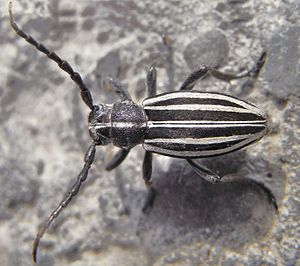Dorcadion scopolii
| Dorcadion scopolii | ||||||||||||
|---|---|---|---|---|---|---|---|---|---|---|---|---|

Pedestredorcadion scopolii |
||||||||||||
| Systematics | ||||||||||||
|
||||||||||||
| Scientific name | ||||||||||||
| Dorcadion scopolii | ||||||||||||
| ( Autumn , 1784) |
Dorcadion scopolii (according to some authors Pedestredorcadion scopolii ) is a beetle from the family of the longhorn beetle and the subfamily Lamiinae . The species is one of the numerous longhorn beetles living on the ground, the center of which is found in south-eastern Europe.
Notes on the name
The species was described by Herbst in 1784 under the name Lamia scopolii as the 12th species of the 37th genus. Herbst remarks: Under this name he (the beetle) was sent to me from Hungary , although I cannot find a description of it in Scopoli . The species name "scopolii" thus refers to the entomologist Giovanni Antonio Scopoli .
The generic name "Dorcadion" (from ancient Greek δορκάς dorkas, gazelle δορκάδιον dorkádion, goat) expresses that it is a question of smaller longhorn beetles. Pedestredorcadion (Latin pedéstris characterized by its legs, because pedestre are red in the similar Pedestredorcadion ; Cribridorcadion is synonymous with Pedestredorcadion ) is traditionally a subgenus of Dorcadion , which was later upgraded to the genus. The genus Pedestredorcadion is represented by over ninety species in Europe and over two hundred species worldwide.
Characteristics of the beetle
The beetle only reaches a body length of 10 to 13 millimeters. The body is elongated oval and black, but appears velvety gray with white stripes because of the very short hair ( tomentation ).
The head is inclined downwards perpendicular to the body axis. The mouthparts point almost vertically downwards, the last link of the jaw probe is spindle-shaped and pointed and not truncated at an angle. The first antennae is strongly built, the second antennae is short, like most longhorn beetles, and the third smaller than the first (Fig. 2). The remaining of the 11 antenna elements taper increasingly towards the outside. In the females the antennae do not reach the middle of the elytra , in the male they hardly exceed it. The kidney-shaped compound eyes encompass the antenna base from behind in such a way that the distance between the bases of the two antennae on the forehead is greater than the distance between the inner edges of the eyes (inner edge marked with a green arrow in Fig. 4).
An important taxonomic feature is that the front edge of the head capsule, the head shield (Fig. 4, red bordered on the right) is bent forward and so lies above the level of the base of the upper jaw (Fig. 4, yellow bordered on the right).
Most striking are the white or yellowish, clearly defined stripes. Five can be seen from above. The middle one runs from the forehead over the pronotum along the wing cover seam to the end of the body. There are also two longitudinal strips on each wing cover. The inner one arises at the inner edge of the shoulder and runs parallel to the wing cover seam. The outer one arises on the outside of the shoulder and runs slightly curved parallel to the outline of the wing cover. The white-lined side edge of the wing covers is turned under. This hem strip is only visible from the side. In addition, the antenna base is ringed in white and the eyes are lined with white.
The pronotum is pulled out laterally into a hump a little behind the middle.
The wing covers are fused together. At the rear end they are rounded together oval.
The legs are built robustly. The five-limbed tarsi appear four-limbed (pseudotetrameric), since the fourth limb is very small and hidden between the lobes of the third limb.
biology
The species loves warmth and occurs in dry, open terrain. The adults eat leaves and roots. They appear in late spring and can be found crawling on the ground. The larvae develop in the soil and feed on the roots of grasses. They need a year to develop.
distribution
The compact distribution area is in southern Eastern Europe. Its border runs through the Czech Republic , Slovakia and Ukraine in the north, through Hungary , Croatia and Serbia in the west, Greece in the south and the European countries bordering the Black Sea in the east .
literature
- Adolf Horion: Faunistics of the Central European beetles. Volume XII. Überlingen-Bodensee 1974.
- Klaus Koch : The Beetles of Central Europe . Ed .: Heinz Freude . tape 3 : ecology . Goecke & Evers, Krefeld 1992, ISBN 3-87263-042-3 .
- Heinz joy, Karl Wilhelm Harde, Gustav Adolf Lohse (ed.): The beetles of Central Europe . tape 9 . Cerambycidae Chrysomelidae . Spektrum Akademischer Verlag, Munich 1999, ISBN 3-8274-0683-8 (first edition: Goecke & Evers, Krefeld 1966).
Web links
Individual evidence
- ↑ a b Pedestredorcadion scopolii at Fauna Europaea. Retrieved December 13, 2010
- ↑ JFW Herbst: Critical Directory of my Insect Collection Archive of Insect History 4, 5 First description of the species p. 91.
- ↑ Sigmund Schenkling: Explanation of the scientific beetle names (genus).
- ↑ Sigmund Schenkling: Explanation of the scientific beetle names (kind).
- ↑ Pedestredorcadion at Fauna Europaea. Retrieved February 23, 2013
- ↑ Cribridorcadion at BioLib.



